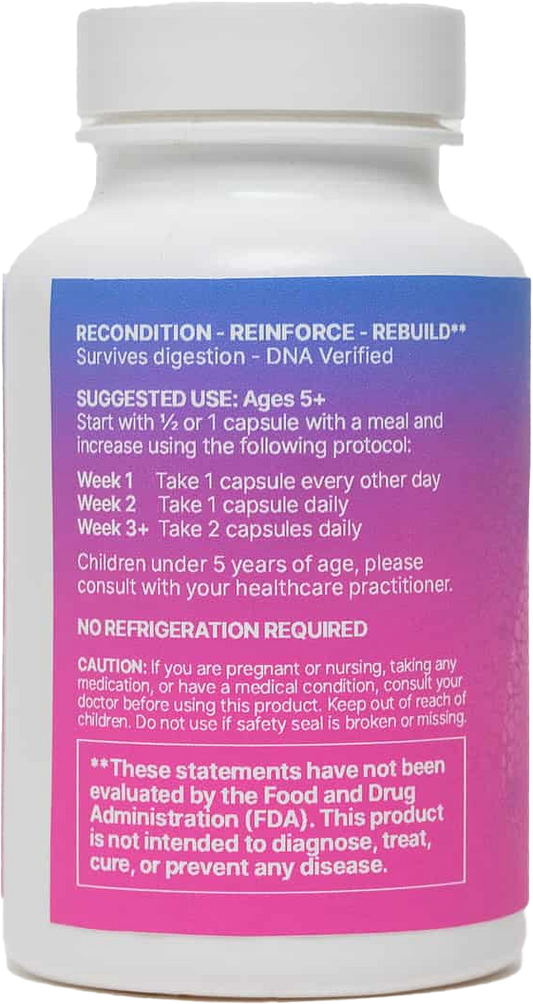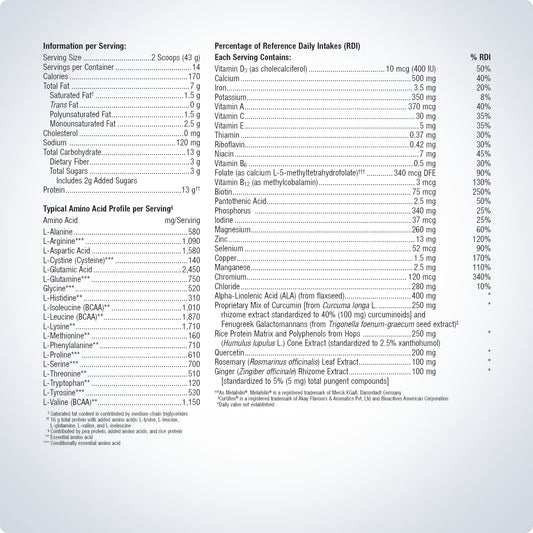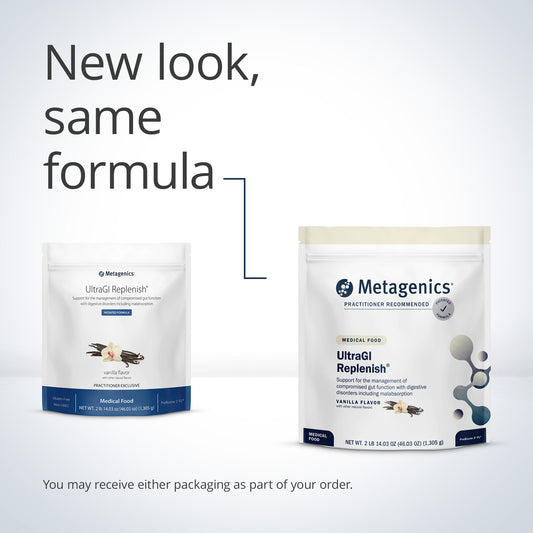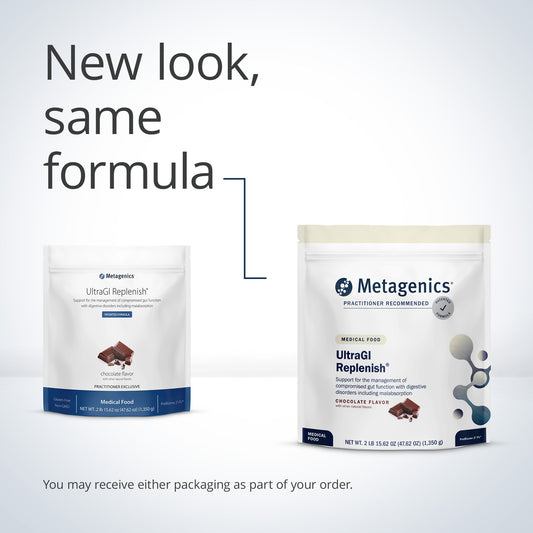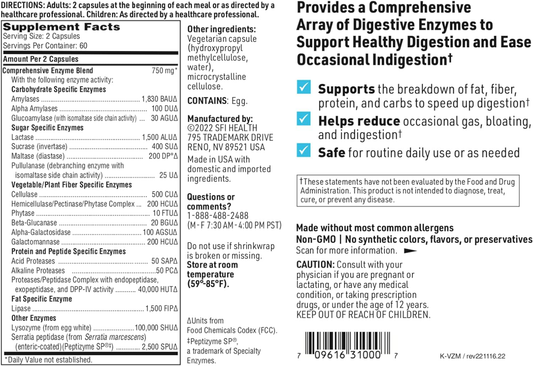The Truth About “Gut Healthy” Soda—How to REALLY Optimize Your Microbiome.

What if soda was actually healthy for you? It’d probably fly off the shelves, right?
That, in fact, is what’s happening with Poppi, a “prebiotic soda” that claims it promotes a healthy gut and reportedly now has a bigger market share than Coke. But is it truly good for your gut? A new class-action lawsuit alleges that, no, it’s not.
Here’s why: To provide good-for-your-gut-health prebiotics, Poppi contains a type of fiber called inulin. Generally speaking, inulin is really good stuff. It’s known as a “prebiotic fiber” because it supports the growth of beneficial bacteria in your gut, helping you maintain a healthy digestive system.
But, according to the lawsuit, because Poppi only contains 2 grams of inulin per can, you’d have to drink four cans to get enough inulin to meet the daily amount considered effective for gut health benefits. And if you do that, the amount of added sugar you’d consume—20 grams (5 grams per can)—would offset any gut health benefits.
It’s a valid point, and the reality is this: If you really want to improve and optimize your gut health, the best way to do that isn’t with a soda. It’s by consuming the highest quality sources of not only prebiotics but also probiotics, both of which are crucial for helping your gut make postbiotics.
That’s a lot of “biotics,” I know—and it can get confusing. I’ll walk you through how they’re different, why each one matters, and the most effective ways to give your gut the nutrition it deserves.
Why Your Gut Health REALLY Matters
A healthy gut is the foundation of a healthy life. That’s not an exaggeration. I’m so convinced of this that I tell everyone: If you’re struggling with your health and don’t know what to do, start with your gut. The answer is almost always there.
That’s because poor gut health—due to what’s known as an imbalanced microbiome—not only negatively affects digestion, but it can also drive autoimmune diseases, thyroid imbalances, chronic illnesses, and mood disorders like depression and anxiety.¹ (Your microbiome is a diverse ecosystem of microorganisms, including bacteria, viruses, fungi, and archaea that live in your digestive tract.)
On my own healing journey, I realized that a healthy gut microbiome was essential for my well-being. Along with stress management, regular exercise, and targeted supplementation, I prioritized nourishing my gut with the right nutrients. By cutting out harmful elements like ultra-processed foods and incorporating prebiotics and probiotics into my diet, I restored my microbiome—and restored my health. And since then, I’ve seen countless patients do the same.
That brings us to prebiotics and probiotics.
People often get confused by the terms “prebiotics” and “probiotics” so let’s first clear that up. Prebiotics, found in certain fibers, feed the beneficial bacteria in your gut. Probiotics, on the other hand, add more beneficial bacteria.
Most people usually think of bacteria as something that causes disease, but your body is full of bacteria, both good and bad. You want to keep and nourish the good ones and get rid of the bad ones.
Together, optimizing your intake of prebiotics and probiotics can help you create a thriving gut environment, essential for maintaining your overall health. Let’s take a look at how you can do just that.
What do prebiotics actually do?
Essentially, prebiotics are a type of fiber found in many plant foods. This fiber literally feeds your good bacteria and encourages their growth, promoting a healthy digestive system. Some examples of prebiotics include inulin (the stuff they put in Poppi), fructooligosaccharides (FOS), galactooligosaccharides (GOS), and oligofructose.²
When you eat prebiotic-rich foods, they travel to your gut where beneficial bacteria ferment—or metabolize—the fiber in them. This fermentation process produces types of fat known as a short-chain fatty-acid. (“Short-chain” describes its chemical structure.) Can you guess what these short-chain fatty acids are? They’re postbiotics. And these postbiotics can nourish the cells lining your colon, reduce inflammation, and support overall gut health.³
So, by including prebiotics in your diet, you’ll generate more postbiotics, which gives your gut the nutrients it needs to stay healthy and keep you feeling good.
How do you get enough of these prebiotics?
Here’s the hack for optimizing your prebiotic intake: Eat 30 grams of fiber per day. (Women need a little less at 25-28 grams; men a little more at 31-34 grams.) Turns out, most folks are nowhere near these values—the average American consumes just 17 g of fiber per day according to the British Medical Journal—so this is often a great opportunity for improving your health with food.⁴
My personal favorite fiber-rich foods are:
- Chia Seeds: 2 tablespoons (10 grams of fiber)
-
Resistant starches (different types of legumes):
- Lentils: 1 cup cooked (15.6 grams of fiber)
- Black or Kidney Beans: 1 cup cooked (15 grams of fiber)
- Chickpeas: 1 cup cooked (12.5 grams of fiber)
- Avocado: 1 medium avocado (10 grams of fiber)
- Nuts (almonds, walnuts): ~⅔ cup (6-10 grams of fiber)
- Pears: 1 medium pear (5.5 grams of fiber)
- Quinoa: 1 cup cooked (5.2 grams of fiber)
-
Polyphenol-rich foods (bright-colored foods):
- Broccoli: 1 cup cooked (5 grams of fiber)
- Strawberries or Blueberries: ~¾ cup (2-4 grams of fiber)
- Raspberries: 1 cup (8 grams of fiber)
- Beets: 1 cup (4 grams of fiber)
- Dark Chocolate (70% cocoa or more): 2 ounces (6 grams of fiber)
For delicious and easy-to-make recipes, check out my new The Young Forever Cookbook, featuring many of these fiber-rich, gut-nourishing ingredients.
Next up: Probiotics.
Probiotics offer similar benefits to prebiotics, but through a different mechanism. While prebiotics provide food for the good bacteria in your gut, probiotics directly add more of these beneficial microbes into your system. And as a result, you produce more postbiotics, which aid digestion, improve nutrient absorption, and promote overall gut well-being.3 Win-win-win.
How do you get probiotics?
You can start by these eating these food regularly:
- Yogurt: Choose unsweetened yogurt from grass-fed milk (preferably goat or sheep) with live active cultures.
- Sauerkraut or kimchi: Fermented vegetables are great sources of probiotics.
-
Kombucha: This fermented tea contains beneficial bacteria and yeast for your gut.
(I choose unpasteurized varieties because pasteurization kills both the bad and good bugs.)
Of course, you might not like those foods, or you could find it challenging to eat them regularly. Or maybe you just want to ensure you’re truly optimizing your intake of good bugs. Enter supplements.
Probiotic supplements are an easy way to consistently supply your gut with good bacteria. That’s exactly why I take this prebiotic and probiotic formula by Seed every day. Supplementation can also be helpful for anyone dealing with yeast overgrowth or histamine intolerance and who wants to avoid fermented foods.
Want more ways to get plenty of prebiotics and probiotics? Check out my favorite gut-friendly recipes and tips for maintaining a balanced diet.
Your Next Step
- Evaluate your diet: Take a close look at your current eating habits. Are you getting enough fiber? Are you consuming fermented foods regularly?
- Strive for consistency: This is how you truly impact your gut health. Aim to make the gut-friendly foods I’ve talked about here a regular part of your diet rather than occasional additions.
- Start small (if you need to): Try introducing one new gut-friendly food—whether it has prebiotics or probiotics—into your diet every week or two. For example, you could add a serving of kimchi to your lunch or swap your usual snack for a handful of nuts. Alternatively, you could focus specifically on increasing your fiber intake—by enjoying any combination of the high-fiber foods I’ve talked about in this article. Start by adding 5 to 10 grams of fiber a day for a couple of weeks. Once you’re consistent, add another 5 to 10 grams until you reach your target.
References
- Madhogaria B, Bhowmik P, Kundu A. Correlation between human gut microbiome and diseases. Infect Med (Beijing). 2022 Aug 24;1(3):180-191. doi: 10.1016/j.imj.2022.08.004. PMID: 38077626; PMCID: PMC10699709.
- Pandey KR, Naik SR, Vakil BV. Probiotics, prebiotics and synbiotics- a review. J Food Sci Technol. 2015 Dec;52(12):7577-87. doi: 10.1007/s13197-015-1921-1. Epub 2015 Jul 22. PMID: 26604335; PMCID: PMC4648921.
- Singh RK, Chang HW, Yan D, Lee KM, Ucmak D, Wong K, Abrouk M, Farahnik B, Nakamura M, Zhu TH, Bhutani T, Liao W. Influence of diet on the gut microbiome and implications for human health. J Transl Med. 2017 Apr 8;15(1):73. doi: 10.1186/s12967-017-1175-y. PMID: 28388917; PMCID: PMC5385025.
- McKeown NM, Fahey GC Jr, Slavin J, van der Kamp JW. Fiber intake for optimal health: how can healthcare professionals support people to reach dietary recommendations? BMJ. 2022 Jul 20;378:e054370. doi: 10.1136/bmj-2020-054370. PMID: 35858693; PMCID: PMC9298262.
- Ma L, Tu H, Chen T. Postbiotics in Human Health: A Narrative Review. Nutrients. 2023 Jan 6;15(2):291. doi: 10.3390/nu15020291. PMID: 36678162; PMCID: PMC9863882
Related Longevity Articles
Gut Health Support
The gastrointestinal system, or digestive system, is responsible for processing food and absorbing nutrients, involving organs such as the stomach, intestines, liver, and pancreas. It plays a crucial role in breaking down food, extracting nutrients, and eliminating waste to maintain overall digestive health.
-
MegaSporebiotic
Regular price $64.95 / 60 CapsulesRegular priceUnit price / per -
CandiBactin-AR
Regular price $51.75 / 60 Softgel CapsulesRegular priceUnit price / per -
CandiBactin-BR
Regular price $51.75 / 90 TabletsRegular priceUnit price / per -
UltraInflamX PLUS 360 (Pineapple-Banana)
Regular price $83.50 / 14 ServingsRegular priceUnit price / per -
UltraInflamX PLUS 360 (Original Spice)
Regular price $83.50 / 14 ServingsRegular priceUnit price / per -
Digestive Enzymes Ultra 180 ct.
Regular price $64.00 / 180 CapsulesRegular priceUnit price / per -
UltraInflamX PLUS 360 (Mango)
Regular price $83.50 / 14 ServingsRegular priceUnit price / per -
UltraGI Replenish® Gut Support Vanilla
Regular price $119.00 / 2lb PowderRegular priceUnit price / per -
Vitamin D Supreme
Regular price $38.49 / 60Regular priceUnit price / per -
Glutagenics
Regular price $77.50 / 60 ServingsRegular priceUnit price / per -
UltraGI Replenish® Gut Support Chocolate
Regular price $119.00 / 2lb PowderRegular priceUnit price / per -
Ther-biotic Vital-Zymes Complete
Regular price $43.99 / 120 CapsulesRegular priceUnit price / per -
Zinc citrate 60 ct.
Regular price $12.20 / 60 CapsulesRegular priceUnit price / per
Login
- Choosing a selection results in a full page refresh.
- Opens in a new window.









